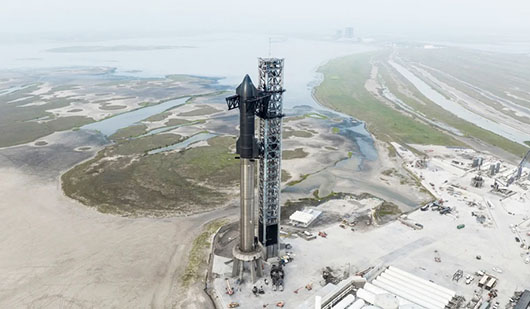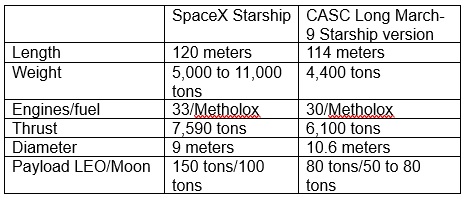FPI / April 26, 2023
By Richard Fisher
Following the April 20 spectacular SpaceX test explosion, China made an announcement that did not receive much media attention.

Soon after SpaceX Corporation’s first full two-stage test of its revolutionary super heavy Starship reusable space launch vehicle and also the world’s largest SLV, China revealed that it will ape Starship, creating an almost dead-ringer two-stage fully reusable SLV.
In a briefing conducted by the China Lunar Exploration Program (CLEP) at the International Deep Space Exploration conference in Hefei, held in conjunction with China’s April 24 “Space Day,” two slides revealed for the first time that the China Aerospace Science and Technology Corporation (CASC) Long March-9 (LM-9) super heavy SLV that previously was revealed to have only a reusable first stage, will now be developed to have a reusable second stage.
In addition, the LM-9 reusable second stage utilizes a canard, or stabilizer-in-front configuration just like the SpaceX Starship, indicating that it will also, like Starship, use a lower-speed near vertical atmospheric reentry profile that reduces reentry heat and airframe stress, before conducting a vertical landing.
The reusable LM-9, unofficially designated the LM-9D, will be developed into versions that use a reusable first stage and two sizes of single-use second stages, likely for lofting heavy payloads up to 150 tons to Low Earth Orbit, or vehicles with independent propulsion for landing on the moon and Mars.
A second slide from the CLEP presentation indicates that a reusable second stage version will emerge around 2040 and be able to loft 80 tons to LEO, meaning it may have the potential to loft about 50 to 80 tons to the moon.
Data from the CLEP slide allows for a table that compares rough size and performance indicators for Starship and the reusable Long March-9.

The CLEP slide also indicates for the first time that LM-9 testing could begin in 2033, whereas previous Chinese disclosures had indicated that the reusable version of the LM-9 would not begin testing until 2035.
The LM-9 schedule is further confused by a suggestion to the author from a CASC officials at the recent February 2023 IDEX weapons exhibition that CASC could develop both reusable and single use versions of the LM-9, of which the later may start testing in 2030.
But with the development of a reusable second stage, CASC is at least implying that like Starship, it will employ Low Earth Orbit refueling to higher payloads to be transported to the moon.
Full Text . . . . Current Edition . . . . Subscription Information
Free Press International
